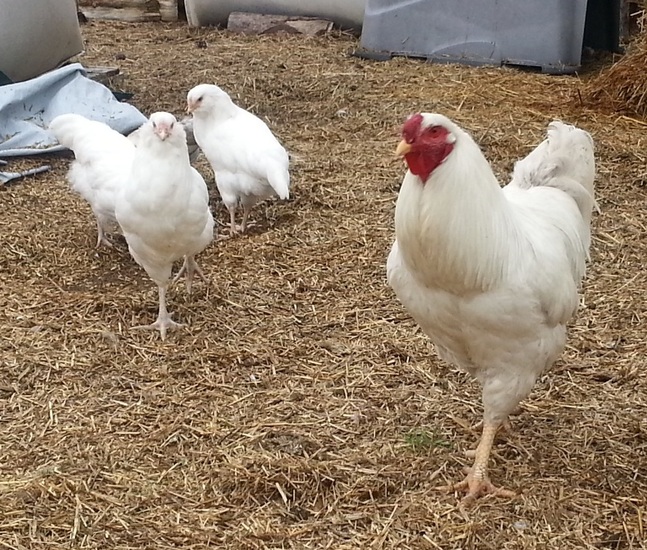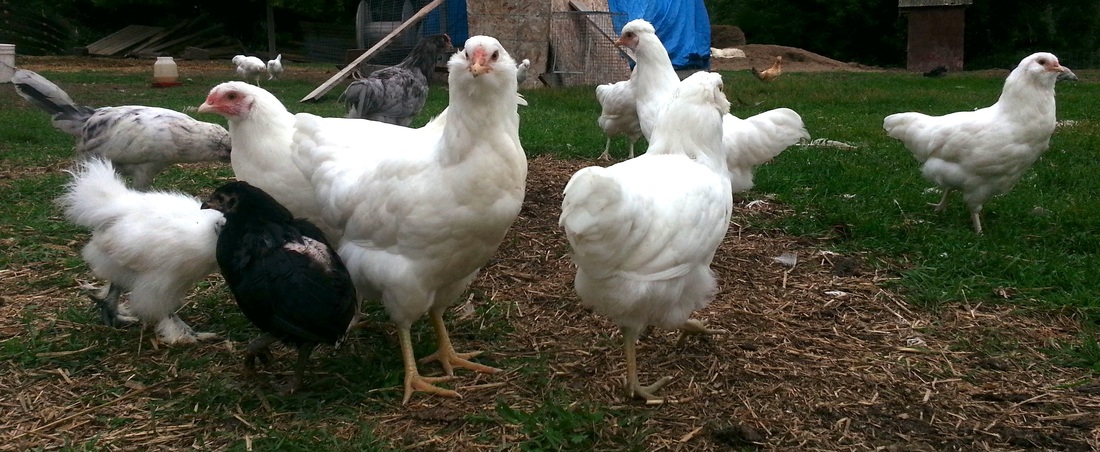 The Chantecler rooster, a nice large specimen of the breed.
The Chantecler rooster, a nice large specimen of the breed. But, I was determined to beat this phobia. I bought a budgie bird for my mother when I was a teenager and could not put my hand in the cage. If the bird was out to fly, I was out of the room like a flash. It did not work.
What did help, finally, was when I got the first lot of just hatched chicks and one had a syndrome which twists the head and makes the chicken go backwards in circles. I was determined to save it, though that meant I had to pick it up to dropper feed it. I dressed in coveralls, hat and gloves, absolute arsenal for the chick, deathly afraid to pick it up even wearing heavy leather gloves. But, its life depending on me doing so, and I steeled my will and dropper fed this creature several times a day. Then one day, it was standing upright and peeping. I had done it with the grace of the Creator. And the chick had saved me too, because I was not as afraid as before.
As time progressed, I got more and more comfortable around the birds, chickens not as much as ducks because chickens could fly and the wing flapping sent me into the state of terror. Now, I have chickens, ducks, geese, guinea hens and turkeys. I can go in the coop, pick up the birds and I am not in the least afraid, except when I have to be in a closed coop catching them and they fly. Then the little hairs on the back of my neck stand on end and I breathe heavily and still feel as though I am going to die. I have caught adult geese and caged them, turkeys of all stages and chickens, ducks and ducklings and all except the guineas who do not like to be caught.
What I have learned about chickens is they are like people. Some are better than others. Some breeds are better but within each breed, there are huge differences too, just as within any race, the individuals are all different. First I had no idea about chickens, so tried a lot of breeds, just two or three of each. Some ate too much and were too lazy, others were flighty and unapproachable, and some fared extremely poorly in our bitterly cold winters. Finally, for this climate and my purposes, I settled on two main breeds, Chateclers, both white and partridge coloured, and Ameraucanas. The Ameraucanas I got were coloured blue, black and spotted, called splash, though I much preferred the Wheaten variety which look just like the rooster on the Corn Flakes box, only prettier. The Chanteclers are super winter hearty being developed in Quebec and Alberta, and the Ameraucanas are the best forager birds I have experienced.
My aim then was to create Chatecaunas, the cross between the two breeds, so the birds would be better foragers and convert their food better than the fat lazy breeds, and bigger, stronger, healthy birds, since the roosters are put in the freezer each fall. This is the first year for the Cantecaunas and they are beautiful. Most are white, but some are blue, black or splash coloured and they are friendly and docile, but out to forage as soon as the sun is up. The egg laying will be telltale in the spring next year, unless they begin to lay before winter and lay throughout the winter.
I am seeking a special Ameraucana rooster and another Chantelcer rooster for the next breeding of the birds. The adult hens will be put with the new roosters to produce another strain of the Chantecaunas and the first strain will be bred to the second strain to produce the first true Chantecauna birds. The best of the bunch will be selected for breeding to the finest rooster produced by the first breeding. Of course they will have to separated for this breeding.
So, what I have learned about chickens is that they are not all the same. Each person must find the breed that suits them the best according to the needs they have. If the birds are to be confined to a coop and covered run, the foraging ability is not useful. If they want big fat lazy chickens because they like to eat big fat chickens that are more tender because they have been confined and do not use their muscles, then the breeds they choose would reflect that choice. Some just like pretty feathers, do not even eat the chickens or the eggs, and keep the birds in small cages so they remain undamaged and pristine. Though I do not condone showing birds or any animals, there are breeds for that too.
The final aspect for me about chickens are the eggs. I eat duck eggs primarily, which are three times more nutritious than chicken eggs, so the eggs are a by product of keeping the birds. The birds are fed organic wheat and oats in the summer, with added seeds and vegetables in the winter. They forage from sun up to sun down in the entire barnyard, through the goat, sheep, llama, rabbit and alpaca manures and spent hay and eat tons of grass. The mosquito and fly populations in the yard are minimal, but step out to the pasture and clouds of them come to eat you alive. So, the birds do the job they are here for well, and the eggs, though they are some of the best in this area, do not sell. People here could care less about their food being organic and clean, and will only pay 2 or 3 dollars for a dozen eggs, but will pay 5 or 6 dollars for an iced coffee from Tim Horton's or a hundred dollars for alcohol without batting an eye. So, I give some eggs away and the feed some back to the animals and compost the rest. The food bank is not allowed to accept farm eggs, sad to say, so they are thrown out.
Chickens are valuable on farms and should be kept free range. My dogs, bless each and every one of the seven, keep the chickens safe from predators so they can do their jobs and do not have to be kept in cages or runs and confined. Chickens should also be kept in the cities, three hens or so in movable cages with no bottoms and an insulated sleeping compartment. They will eat bugs, grass and fertilize as well as provide a family with fresh eggs, no rooster required. Before purchasing chickens, I urge people to ask themselves why they want them and what their purpose will be so they can select the proper breed. If they are to be confined, there are breeds that bear confinement without adieu, where others would be unhappy and nearly die without the freedom to roam.
I almost forgot about the setting ability. Many breeds are not good setters, because they have been bred for other traits. That is why I have included Silkies and Bantams in my mix. They will hatch a clutch of eggs per year. Some lines of Ameraucanas and Chanteclers will also sit on a nest. I have one such hen who has 12 little white Chantecaunas running around with her. Having a mother hen raise the chicks is the most ideal, dispensing with heat lamps, brooders, chick feed and time. The chicks the mother hen raises are not fed anything special on this farm, nor are they confined. She takes them around and teaches them what to eat and also provides the best brooder, her warm breast, to keep them toasty and safe. The only problem is the chicks are wild and will not be calm in the coop, if they go there at all. One year, the hen raised brood settled under the coop and eventually froze to death in the winter. Last year, we caught the hen raised brood in the fall and locked them in the coop for a week to teach them where they should rest in winter and that worked, so it might have to happen again. Right now, there are 6 ducks sitting on nests and one guinea sitting on 8 Muscovy eggs. I don't know if the guinea hen will mother the ducklings if she hatches them at all. Time will tell.
When looking for chickens, make a list of the traits desired, the type of housing offered (confined or free) and the end result wished for (eggs or meat) and then find a breed that is most suitable. Happy Farming with chickens! The Fat Ewe Farm would not be without them.




 RSS Feed
RSS Feed